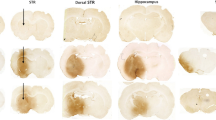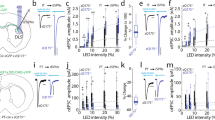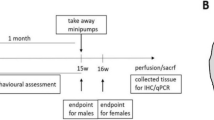Abstract
SYSTEMIC administration of large doses of L-glutamate to immature animals causes degeneration of neurones in the retina and the arcuate nucleus. Olney et al.1 reported that intracerebral injections of the more potent excitatory analogues of glutamate, in particular kainic acid, caused rapid degeneration of certain dendritic and somal structures in the injected area. Presumably the degeneration is related to the ability to bind the ‘excitotoxic’ agent, with necrosis resulting from a sustained increase in membrane permeability. 3H-kainic acid binds more strongly to striatal tissue than to any other area of rat brain tested2. This lends some support to Spencer's theory3—based on antagonism of cortical excitation of striatal neurones by diethyl glutamate—that the massive corticostriatal pathway is glutaminergic. If Huntington's chorea were an excitotoxic phenomenon resulting from chronic overstimulation of glutamate receptors, striatal neurones in particular would be affected because of heavy glutaminergic input. This hypothesis is not readily tested by simple measurement of glutamate in choreic tissue because glutamate is a precursor of γ-aminobutyric acid (GABA) and is also involved in other metabolic activities. As one potential test of this hypothesis, we have injected 1 µl of either kainic acid or L-glutamic acid dissolved in isotonic saline directly into the extrapyramidal nuclei of rats. Injection into the striatum produced local enzymatic changes duplicating those reported in Huntington's chorea.
This is a preview of subscription content, access via your institution
Access options
Subscribe to this journal
Receive 51 print issues and online access
$199.00 per year
only $3.90 per issue
Buy this article
- Purchase on Springer Link
- Instant access to full article PDF
Prices may be subject to local taxes which are calculated during checkout
Similar content being viewed by others
References
Olney, J. W., Sharpe, L. G., and de Gubareff, T., Neurosci. Abst., 5, 371 (1975).
Simon, J. R., Contrera, J. F., and Kuhar, M. J., J. Neurochem., 26, 141–147 (1976).
Spencer, H. J., Brain Res., 102, 91–101 (1976).
Konig, J. F. R., and Klippel, R. A., The Rat Brain (Williams and Wilkins, Baltimore, 1963).
McGeer, P. L., and McGeer, E. G., J. Neurochem., 26, 65–76 (1976).
Bird, E. D., and Iversen, L. L., Brain, 97, 457–472 (1974).
Stahl, W. L., and Swanson, P. D., Neurology, 24, 813–819 (1974).
McGeer, P. L., Grewaal, D. S., and McGeer, E. G., Brain Res., 80, 211–217 (1974).
Stadler, H., Lloyd, K. G., and Bartholini, G., Naunyn Schmeidebergs Arch. Pharmac., 283, 129–134 (1974).
Author information
Authors and Affiliations
Rights and permissions
About this article
Cite this article
MCGEER, E., MCGEER, P. Duplication of biochemical changes of Huntington's chorea by intrastriatal injections of glutamic and kainic acids. Nature 263, 517–519 (1976). https://doi.org/10.1038/263517a0
Received:
Accepted:
Issue Date:
DOI: https://doi.org/10.1038/263517a0
This article is cited by
-
Cell-Autonomous and Non-cell-Autonomous Pathogenic Mechanisms in Huntington's Disease: Insights from In Vitro and In Vivo Models
Neurotherapeutics (2019)
-
Neuroprotective strategies for NMDAR-mediated excitotoxicity in Huntington’s Disease
Frontiers in Biology (2016)
-
A mitochondrial basis for Huntington’s disease: therapeutic prospects
Molecular and Cellular Biochemistry (2014)
Comments
By submitting a comment you agree to abide by our Terms and Community Guidelines. If you find something abusive or that does not comply with our terms or guidelines please flag it as inappropriate.



